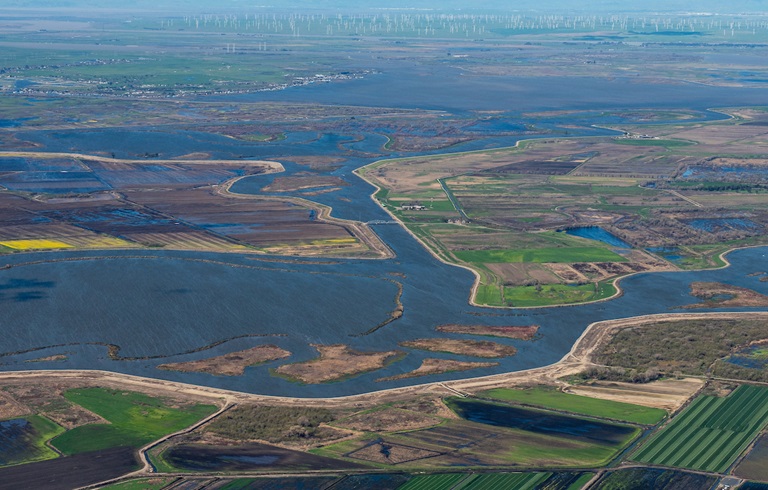Delta Conveyance: A Fresh Look Yields a New Project
Aerial view of the Sacramento- San Joaquin Delta in San Joaquin County. 
Modernizing how California moves water supplies across the Sacramento-San Joaquin Delta can’t be done by repeating the past. It requires starting with a fresh look and an open mind. That is what the Delta Conveyance Project (DCP) team did and the result, to be detailed shortly with the release of draft environmental documents, is a proposed project that is different than anything advanced in the last four decades.
Here are highlights of some refinements DWR made for the proposed Delta Conveyance project, going from north to south. A number of contributors, from Delta residents to some of the best engineering minds in the water business, provided suggestions that have helped inform these refinements.
The Intakes:
A traditional large water intake, like the one at Freeport, has tall metal vertical screens that stretch along a bend of a river and are visible from a distance. Giant brushes clean them daily, sometimes even hourly. The system that drives these brushes often creates a screeching sound that can annoy neighbors.
With this in mind, the proposed project does not use traditional water intake. Instead, DCP opted for screens wrapped into horizontal cylinders that are shorter in length than the vertical variety. They are located completely below the water surface, including their brush cleaning systems, therefore, the visual impact is minimized and the noise impact eliminated. The DCP team didn’t have to look far to find these screens. They were developed and are sold by a local company based in the Delta.
The Tunnel:
Once diverted, the water begins its southbound journey in a single tunnel. The DCP proposes a tunnel capacity of 6,000 cubic feet per second. The previous proposal was 50 percent bigger than that and the so-called “Peripheral Canal” proposal of 1980 was more than three times the capacity.
An independent panel of experts advised that today’s tunnel boring machines can dig twice as far as we thought only a decade ago. That shrunk the number of sites needed to place these boring machines into the ground from six to two. A forebay, which is a human-made reservoir, about half-way along the route once thought to be necessary was eliminated as well. These changes alone preserve hundreds of acres of Delta farmland.
The Power:
Tunnel machines use sizeable amounts of electricity, meaning that new power transmission is required at the two DCP shaft sites. The majority of new power lines will be installed underground or on existing poles. This is particularly helpful for the hundreds of thousands of birds along the Pacific Flyway that use the Delta as their home for part of the year as electric lines can be a collision threat to birds. This route also helps avoid conflicts with Sandhill Cranes flying between lands in the Woodbridge Ecological Reserve and has no footprint in the Stone Lakes National Wildlife Refuge.
The Route:
The tunnel route stays to the east unlike the previous conveyance route that went through the heart of the Delta. The route largely follows major roads like Interstate 5 which reduces major construction activities in rural landscapes connected only by two-lane roads. This route also ends at a location that no previous conveyance project had contemplated.
Bethany Reservoir, 1.5 miles south of the State Water Project’s existing pumping system in the southern Delta, marks the beginning of the California Aqueduct. The proposed tunnel route connects it directly into Bethany Reservoir. This eliminates the need to construct a whole new forebay next to Clifton Court, preserving over 1,000 acres of farmland and nearby wetlands.
The Operations:
The two new intakes in the northern Delta would only be used when the same water can’t be safely captured by the existing system in the winter and spring. This new approach lessens changes to flow patterns in the estuary.
No final decision on any aspect of this proposed project has been made. The upcoming release of the draft environmental impact report creates an important opportunity to listen to the public and look at the project with fresh eyes.
View this fact sheet for additional information on preliminary design and engineering objectives and resulting refinements.
For more information on the delta conveyance project, please visit DWR’s Delta Conveyance webpage or subscribe to our mailing list.
